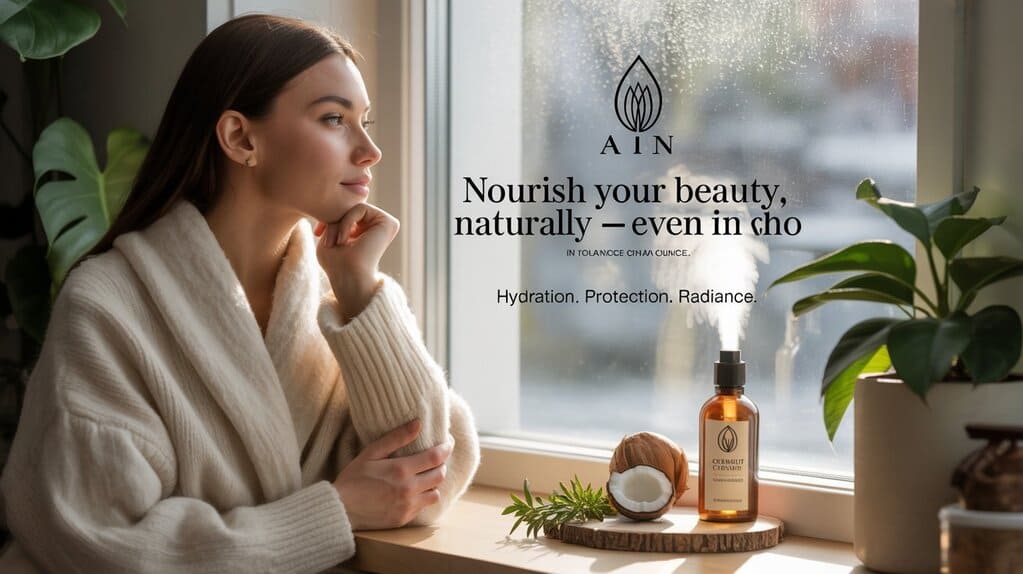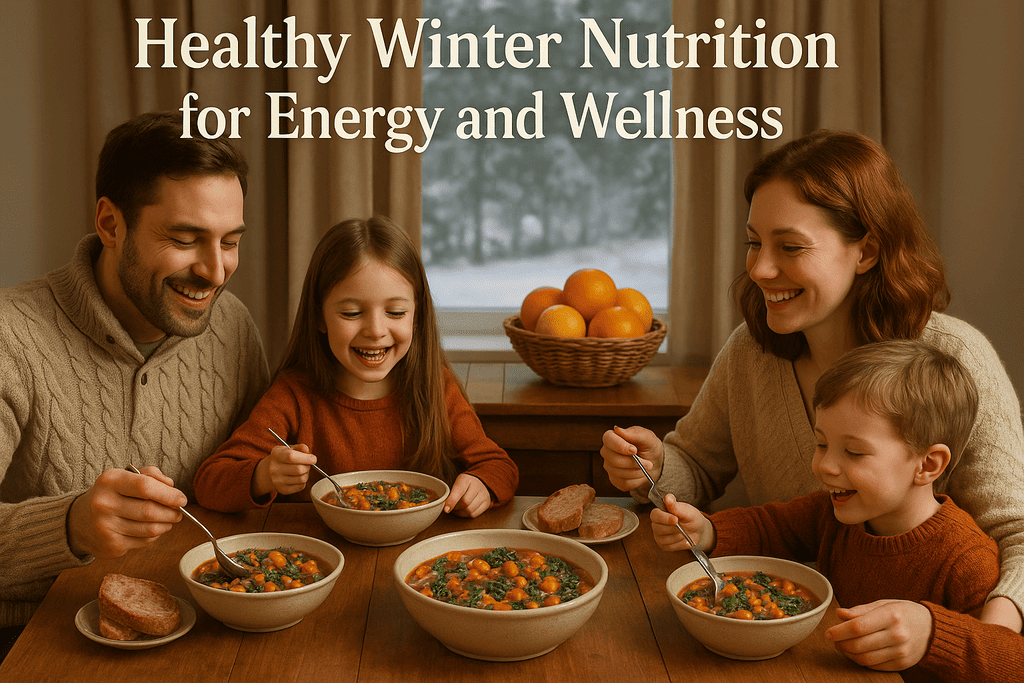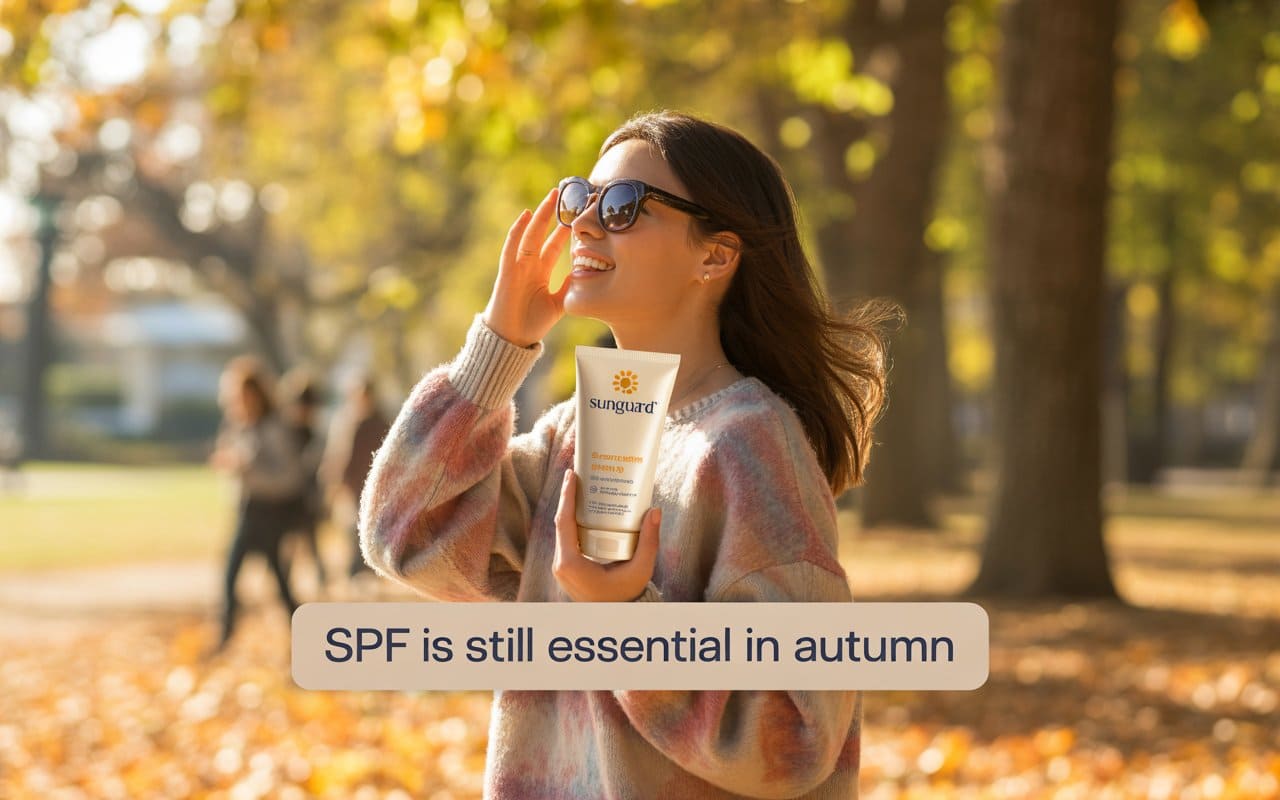
Introduction
As late summer eases into early autumn, your skin navigates a subtle but important environmental shift: UV intensity gradually declines yet remains strong at mid-day, humidity often drops, indoor heating begins to cycle on, and outdoor allergens can rise. Together these changes can dull radiance, worsen dehydration, and trigger post-summer hyperpigmentation (dark spots) or sensitivity. The key to a true “autumn glow” isn’t a wholesale routine overhaul; it’s a smart seasonal recalibration grounded in skin biology and supported by clinical evidence. Below you’ll find a complete, SEO-optimized guide—covering the skin barrier, antioxidants (like vitamin C and green tea catechins), exfoliants (such as AHAs), hydrators (especially hyaluronic acid), and cornerstone sun protection—with recent studies from Asia, America, and Europe and citations you can trust.
Bottom line: Preserve and rebuild your stratum corneum (outer barrier), correct UV-induced dullness and dark spots, keep using broad-spectrum SPF, and time your actives so they work with your skin’s rhythm. WikipédiaAcadémie Américaine de DermatologieScienceDirect
Key Points (Quick Read)
- Keep SPF 30+ broad-spectrum in your daily routine even in autumn; UV can still be high, especially mid-day. Reapply every 2 hours outdoors. Académie Américaine de DermatologieU.S. Food and Drug Administration
- Repair the skin barrier with ceramides and pH-friendly cleansers; barrier health = glow. Oxford AcademicJDS Journal
- Fade post-summer spots with vitamin C (L-ascorbic acid) and niacinamide 2–5%, supported by clinical evidence. PMC+1Wiley Online Library
- Use AHAs (glycolic or lactic acid) sparingly to smooth texture; pair with sunscreen. PMCMDPI
- Rehydrate with hyaluronic acid serums and a richer ceramide moisturizer as nights get drier. PMCOxford Academic
- Introduce retinoids gradually at night to boost collagen and refine tone/texture. PMCHarvard Health
- Respect circadian rhythms: barrier function tends to dip in the evening—great time for repair routines. PubMedPMC
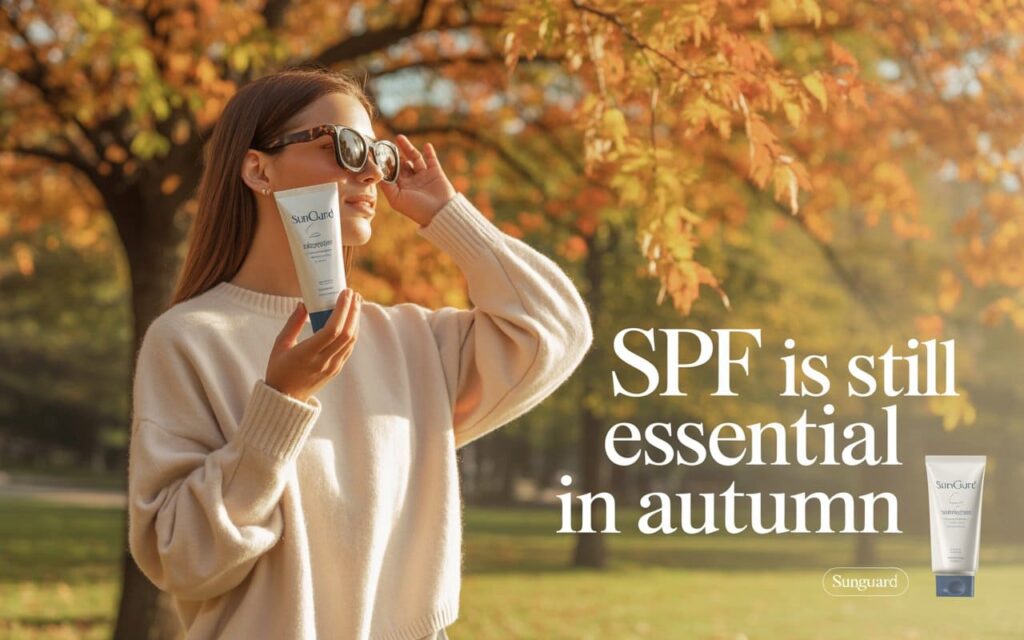
Body
1) Understand Your Barrier: The Foundation of Glow
Your stratum corneum—the outermost epidermal layer—works like a brick-and-mortar wall, with corneocytes (bricks) embedded in a lipid matrix rich in ceramides, cholesterol, and fatty acids (mortar). A resilient barrier prevents transepidermal water loss (TEWL), resists irritants, and reflects light better—translating to visible glow. Seasonal shifts (UV, wind, indoor heat) can elevate skin surface pH, disturb enzymes (kallikreins), and degrade barrier lipids, triggering roughness and sensitivity. Supporting that lipid matrix with ceramide-containing moisturizers improves barrier function and visible smoothness. WikipédiaJDS JournalOxford Academic
What to do now:
- Switch to a pH-balanced, non-stripping cleanser.
- Layer a ceramide + cholesterol + fatty acid moisturizer morning and night.
- Add niacinamide (2–5%); it’s been shown to reduce sebum, brighten, and support barrier lipids across diverse populations. PMC
2) Keep Sunscreen Non-Negotiable—Even as Temperatures Fall
It’s a myth that sunscreen is “for summer only.” UV remains significant in early autumn, particularly around mid-day. The American Academy of Dermatology recommends SPF 30 or higher, broad-spectrum, with reapplication every two hours when outdoors; the FDA echoes proper and regular use and stresses complementary protection (shade, clothing). For glow seekers dealing with hyperpigmentation, consistent daytime SPF is step one to prevent re-darkening of spots while your actives work. Académie Américaine de DermatologieU.S. Food and Drug Administration
Seasonal tweak: As days shorten and humidity drops, choose a moisturizing SPF (look for glycerin, HA, or squalane) to curb tightness. If you’ll sweat mid-day, pick water-resistant formulas (40–80 minutes). Académie Américaine de Dermatologie
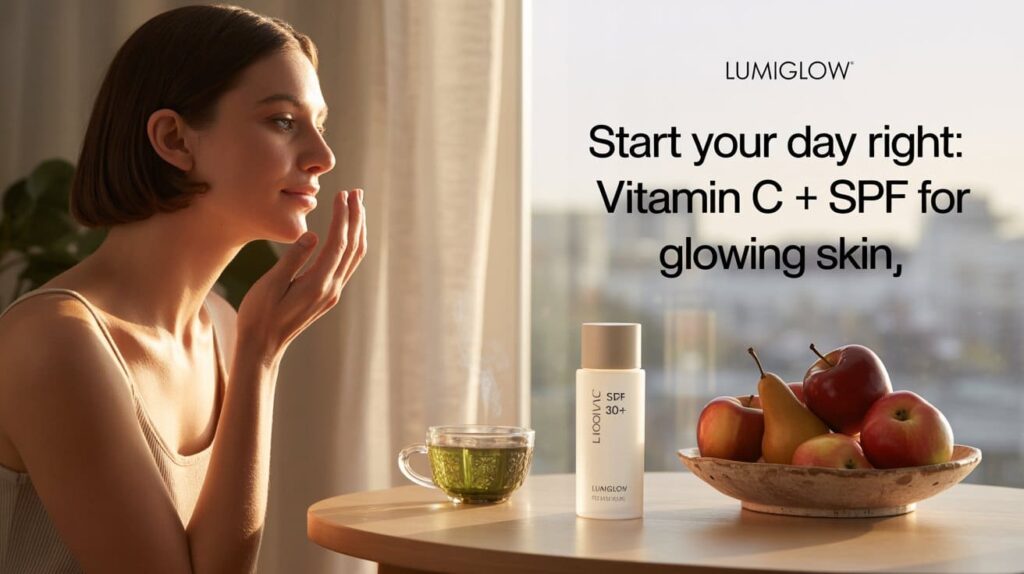
3) Brighten and Defend with Antioxidants: Vitamin C and Green Tea
Vitamin C (L-ascorbic acid) is well-supported for UV-induced free radical scavenging and for melanin pathway inhibition (tyrosinase), making it ideal to treat late-summer dullness and emerging spots. Recent clinical reviews (2023–2024) affirm its role in reducing uneven tone, fine lines, and photoaging markers, though benefits accumulate with consistent use and stable formulas (opaque, air-tight packaging; pH ~3). PMCWiley Online Libraryacofp.org
From Asia-led research, green tea catechins—especially EGCG—show photoprotective and anti-inflammatory actions. Emerging reviews and experimental data suggest benefits to viscoelasticity, collagen support after UV, and potential adjunctive help in acne care. While more large human RCTs are warranted, topical catechin-containing formulas can be a gentle, antioxidant-rich addition to a morning routine (layer under SPF). PMC+1MDPI
How to use (AM):
Cleanse → Vitamin C serum (or EGCG/green tea essence) → Niacinamide (if separate) → Moisturizer → SPF 30+.
4) Reset Texture (Gently) with Chemical Exfoliants
After months of sunscreen, sweat, and outdoor time, AHAs (like glycolic and lactic acid) can smooth the stratum corneum and improve luminosity. Contemporary analyses indicate AHAs promote epidermal renewal and, at peel-strength concentrations, can increase collagen over time. For home use, keep it conservative (e.g., lactic 5–10% or glycolic 5–8% a few nights weekly) to avoid disruption as humidity falls. Always pair with diligent SPF, as exfoliation may increase photosensitivity. PMCMDPI
If you’re managing melasma or stubborn blotchiness, clinic-directed peels (e.g., TCA in combination with brighteners) may accelerate results under professional supervision—especially relevant for medium to deep skin tones in which post-inflammatory hyperpigmentation risk must be minimized with careful protocols. JCAD
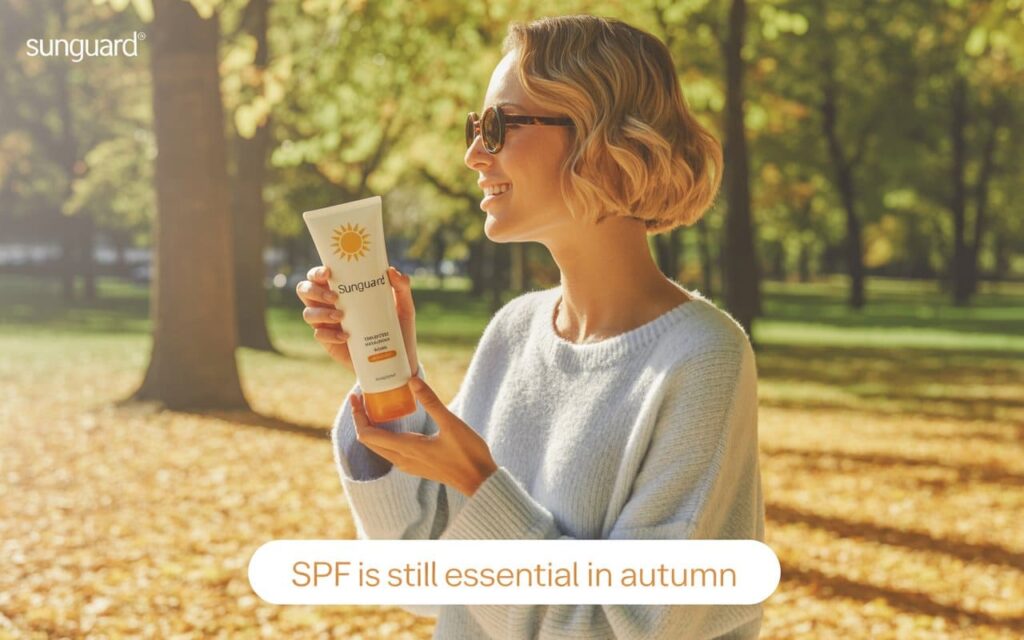
5) Rehydrate Deeply: Hyaluronic Acid and Friends
As nights cool, hyaluronic acid (HA)—a humectant found naturally in skin—becomes a hero for plumpness and light reflection. Multicenter evaluations show topical HA serums can produce immediate and long-term hydration gains, improving smoothness and the look of fine lines. Apply HA to slightly damp skin, then seal with a ceramide-rich cream. In clinic settings (and in research), combinations of topical and oral HA are being explored for additional hydration benefits, but topical remains the most accessible first step for radiance. PMCMDPI
Moisturizer upgrades for autumn:
- Look for ceramides + cholesterol + free fatty acids in ratios that mimic skin’s own lipids.
- Add occlusives (shea, petrolatum, squalane) at night to lock in water without suffocating skin. Evidence supports that strengthening the lipid structure helps the barrier resist irritation and retain water—key to a healthy glow. Oxford Academic
6) Retinoids at Night: Proven Remodeling
Across decades of dermatology research, retinoids—especially prescription tretinoin—have the strongest evidence for improving fine lines, pigment irregularity, and texture by increasing collagen synthesis and normalizing keratinization. Reviews from Europe and the U.S. reiterate their status as anti-aging mainstays; over-the-counter retinol is effective for many, though slower and milder than tretinoin. Start low and slow (e.g., retinol 0.2–0.3% two to three nights per week), buffer with moisturizer, and expect several months for visible change. PMCHarvard Health
Timing tip (science-backed): Skin’s barrier function and TEWL fluctuate over 24 hours; many individuals experience evening barrier dips, making night ideal for reparative actives like retinoids, niacinamide, and barrier creams. PubMedPMC
7) Sun-Smart Habits for Autumn Glow
- Check your local UV Index: UV peaks at mid-day and varies with season, latitude, and cloud cover; in early autumn it can still reach high levels. Protect accordingly. Wikipédia
- Apply enough SPF: dermatologists often recommend the two-finger rule for the face and shot-glass for the body when exposed; reapply every two hours outdoors. Verywell Health
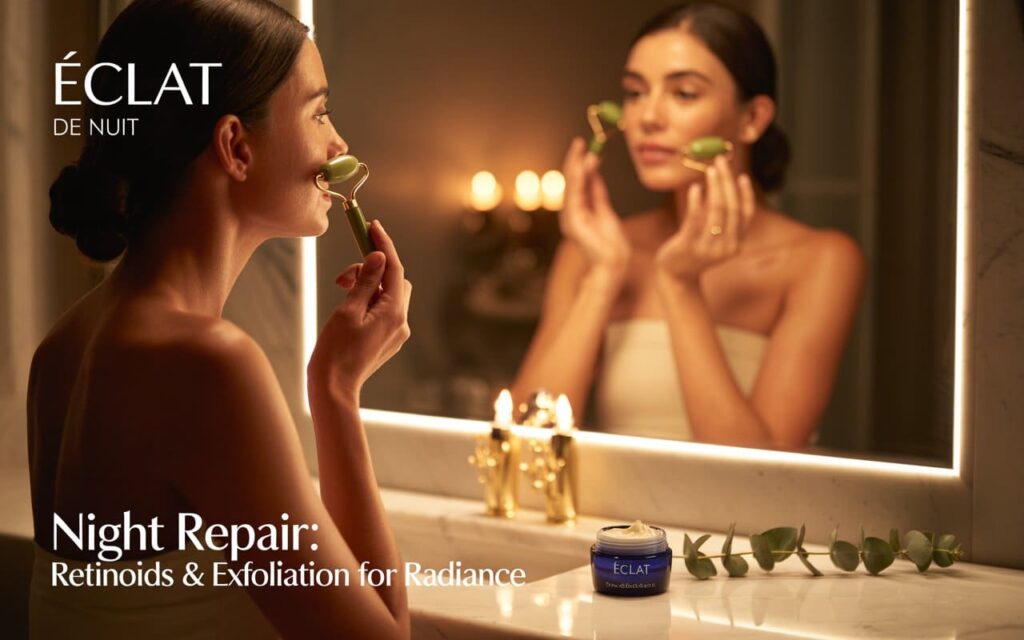
Practical Routines (Late Summer → Early Autumn)
Morning (Glow & Guard)
- Gentle cleanse (pH-friendly).
- Vitamin C (10–15% L-ascorbic acid) or Green Tea/EGCG serum.
- Niacinamide (2–5%) (if not already in your moisturizer).
- Hydrator: HA serum → ceramide moisturizer.
- Broad-spectrum SPF 30+ (reapply when outdoors). PMC+3PMC+3PMC+3Académie Américaine de Dermatologie
Evening (Repair & Rebuild)
- Cleanse.
- AHA 1–3 nights/week (lactic 5–10% or glycolic 5–8%) or retinoid on alternate nights.
- Niacinamide (to calm, brighten, and support barrier).
- Ceramide-rich moisturizer; add an occlusive if air is dry. PMC+2PMC+2Oxford Academic
Table 1. Seasonal “Glow” Tweaks at a Glance
| Concern (Late Summer → Early Autumn) | Why It Happens | Evidence-Based Fix | Notes |
|---|---|---|---|
| Lingering dullness, new spots | UV-generated free radicals & melanogenesis | Vitamin C AM; SPF 30+ | Stable packaging; reapply SPF |
| Tightness/dehydration | Lower humidity, indoor heat | Hyaluronic acid + ceramides | Apply HA on damp skin; seal with cream |
| Rough texture | Summer build-up | AHAs (glycolic/lactic) 1–3×/wk | Go slow; sunscreen daily |
| Fine lines, uneven tone | Photoaging + intrinsic aging | Retinoids at night | Start low; moisturize to buffer |
| Oiliness/redness | Barrier stress; sebum shifts | Niacinamide 2–5% | Multi-benefit, well-tolerated |
Table 2. Hero Actives & How to Use Them
| Active | Core Benefits | Best Time | Starting Use | Who Benefits Most |
|---|---|---|---|---|
| Vitamin C (L-ascorbic acid) | Antioxidant; fades spots; supports collagen | Morning (under SPF) | 10–15% daily | Dull/uneven tone; urban exposure |
| Niacinamide (2–5%) | Brightens, regulates sebum, supports barrier | AM or PM | Daily | Sensitive, oily-combo, redness-prone |
| AHAs (lactic/glycolic) | Smoothes texture; boosts glow | Evening | 1–3×/week | Roughness, congestion |
| Retinoids (retinol/tretinoin) | Collagen support; fine lines; pigment | Night | 2–3×/week → build up | Photoaging, texture |
| Hyaluronic acid | Deep hydration; plumping | AM/PM | Daily | Dryness, tightness |
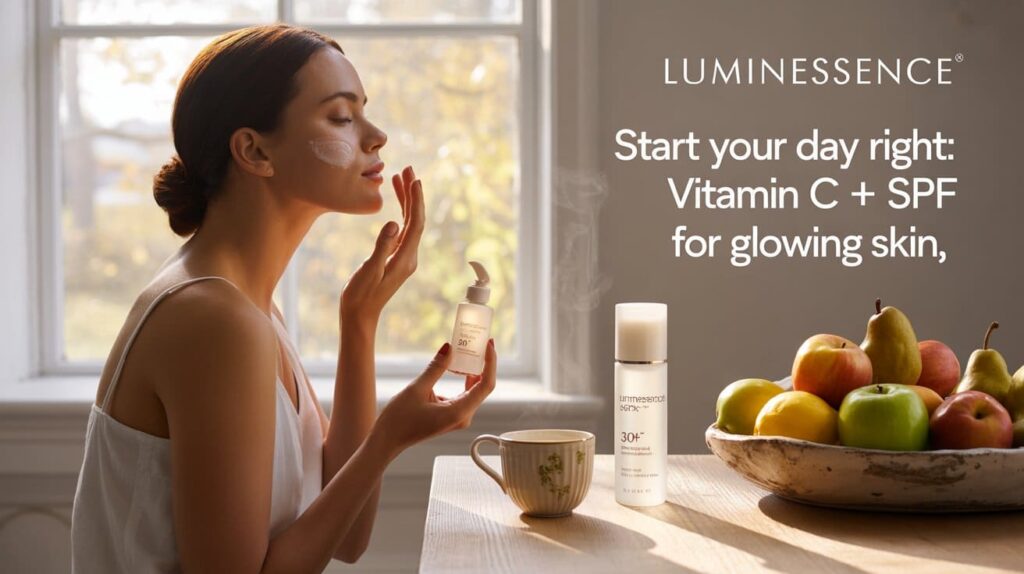
Safety, Sensitivity & Skin Tone Considerations
- Darker skin tones prone to PIH (post-inflammatory hyperpigmentation) should favor gentle lactic acid over strong glycolic initially, add niacinamide for brightening, and consider professional guidance for in-clinic peels. TCA adjunct therapy with hydroquinone/tretinoin has shown benefit under supervision. JCAD
- Sensitive or barrier-impaired skin: prioritize ceramides and niacinamide, introduce retinoids/AHAs slowly, and avoid “stacking” multiple strong actives on the same night. European work emphasizes how restoring the SC lipid matrix reduces irritation risk. Oxford Academic
- Sunscreen myths circulate every season. Evidence-based consensus from dermatologists and regulators still supports daily broad-spectrum SPF, reapplication, and complementary measures (clothing, shade). Académie Américaine de DermatologieU.S. Food and Drug Administration
Conclusion
Glowing skin in late summer and early autumn is not about chasing a dozen trendy products; it’s about aligning your routine with skin biology and seasonal realities. Protect during the day with antioxidants and broad-spectrum SPF 30+; hydrate and rebuild at night with hyaluronic acid, ceramides, and retinoids (introduced gradually). To brighten post-summer discoloration, combine vitamin C (AM) and niacinamide (AM/PM) and reserve AHAs for controlled, gentle resurfacing a few evenings per week. As humidity dips and UV patterns change, these targeted steps keep your barrier intact, pigment balanced, and texture refined—so your glow looks effortless well into autumn.
References (Selected)
- Barrier & Lipids: Kendall AC et al. Br J Dermatol (2022) on topical lipids; overview of SC pH/ceramides and barrier regulation (Sakai T et al., 2025). Oxford AcademicJDS Journal
- Vitamin C: Jaros-Sajda A et al. (2024) review of clinical use in anti-aging; Correia G et al. (2023) efficacy in melasma/photoaging; packaging/stability and practice pearls. PMCWiley Online Library
- Green Tea/EGCG (Asia): Zheng XQ et al. (2024) review on catechins & skin health; Sun J et al. (2024) EGCG post-UV collagen; translational photoprotection data. PMC+1
- Niacinamide: Marques C et al. (2024) mechanistic/clinical overview (2–5% sebum and tone benefits). PMC
- AHAs: Almeman AA et al. (2024) AHA efficacy and mechanisms; Karwal K et al. (2023) clinical collagen data with glycolic/lactic peels. PMCMDPI
- Retinoids: Milosheska D et al. (2022) focused clinical review; Harvard Health (2025) on practical expectations and timelines. PMCHarvard Health
- Circadian Skin: Yosipovitch G et al. (1998) TEWL and pH rhythms; Iwanaszko M et al. (2024) evening barrier worsening in AD. PubMedPMC
- Sun Protection Guidance: AAD selection and SPF ≥30 recommendations; FDA consumer advice on reapplication and complementary protection; UV Index explainer. Académie Américaine de DermatologieU.S. Food and Drug AdministrationWikipédia
- Foundational Overviews: Wikipedia entries on Stratum corneum, Retinoids, Retinol, UV Index for accessible background context. Wikipédia+3Wikipédia+3Wikipédia+3

